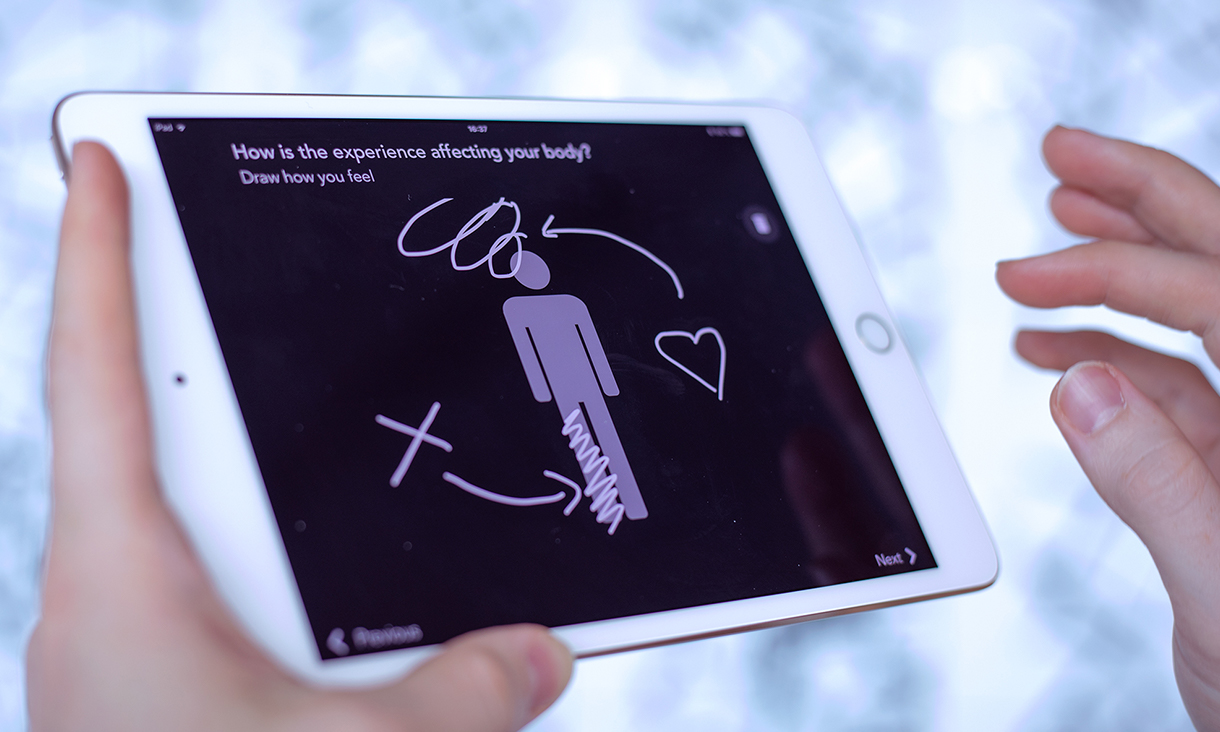New digital tool to improve visitors’ museum experience

Visitors can use the muse platform to draw how they feel about an exhibit at the École polytechnique fédérale de Lausanne (EPFL) Artlab in Switzerland. Credit: Sarah Kenderdine
In summary
- Digital tool ‘muse’ allows for the individualised collection of data around museum visitor experiences
- The platform was co-founded by the Director of Swinburne’s Design Factory Melbourne, Professor Anita Kocsis, and designed by an international research team
- Eight museums in Switzerland are providing industry feedback on the design
Museums come alive through the eyes of visitors. That makes a digital tool like muse invaluable in gathering feedback on visitor experiences.
The creative, forward-thinking design was co-founded by Director of Swinburne’s Design Factory Melbourne, Professor Anita Kocsis, and Professor Sarah Kenderine, who is an expert in digital museology and the director and lead curator the Swiss Federal Institute of Technology Lausanne’s (EPFL) Artlab, and Laboratory for Experimental Museology in Switzerland.

With funding and support from the Migros Pioneer Fund and the Laboratory for Experimental Museology, the international research team launched ‘muse’ in Switzerland in September 2020. Credit: Mary Yacob.
What is muse?
Far from a boring survey, muse features an engaging, interactive design that allows museums to gather feedback on exhibits and other attractions. It allows users to communicate through drawings, voice recordings, interaction with animated graphics or photos they’ve taken. It gathers diverse data on how visitors feel and think.
The platform also aggregates quantitative data, including age, gender, geographic origin and the number of repeat visits, and it is supported in many languages. But it’s the focus on the individual and data analytics of creative expression that makes the platform truly innovative.

Visitors are invited to take a photo of their favourite part of the exhibit or experience in muse – a feature tested at EPFL’s Artlab. Credit: Sarah Kenderdine.
“Through muse, audiences become an active part of the exhibition and assist curators and exhibition designers to explore the value of content presented by cultural organisations,” says Professor Kocsis.
Muse provides real-time feedback on exhibitions and programs, so the experience is more relevant and engaging to visitors. Information collected is based on direct insights through real-time dashboards and data analytics.

A visitor to the Hong Kong Maritime Museum draws her favourite artwork on muse. Credit: Volker Schubert.
The first phase of development was conducted in 2020 in collaboration with eight partner museums in Switzerland: Museum of Design Zurich, the Rietberg Museum in Zurich, House of Electronic Arts Basel (HeK), Geneva Museum of Ethnography (MEG), International Red Cross and Red Crescent Museum in Geneva, the Château de Morges and its museums, the Olympic Museum in Lausanne and EPFL Pavilions.

Live public data from muse was displayed at the World Economic Forum in Tianijin, China. Credit: Allan Jones.
Design innovation at Swinburne
Swinburne’s Professor Kocsis is a pioneer in early-stage design innovation and applied experience research with over fifteen years’ experience in commercial and corporate sectors. She is a leader in design-led innovation, research translation and commercialisation.
Professor Kocsis embraces a co-creative and experimental approach to improving the agency of the human experience in complex, cross-sectoral and interdisciplinary projects. Her work spans science and technology, astrophysics, semi-immersive environments and the ‘co-experience’ of places.
“Experience research through design is an iterative transdisciplinary framework that explores the diffusion of subjective and complex science and technology experiences relevant to broad fields, such as challenges in science communication, health-patient experiences and end use case scenarios,” says Kocsis.
-
Media Enquiries
Related articles
-

- Business
- Technology
Startups lead the way in innovation at 2024 Venture Cup Pitch Night
The 2024 Annual Venture Cup Pitch Night at Swinburne University of Technology celebrated the achievements of seven startups, marking the successful completion of their journey through Swinburne Innovation Studio's accelerator initiative, the Elevate Program.
Monday 02 December 2024 -

- Astronomy
- Technology
- Science
Australia’s moon rover takes off with Swinburne University of Technology developing critical technology for success
Swinburne University of Technology has been selected as a research university that will deliver key technology for Australia’s first lunar rover.
Tuesday 17 December 2024 -

- Design
- Student News
- Technology
- Business
Creative Intersections: Building a better world through creativity and technology
Creative Intersections showcases the innovative fusion of creativity and technology, highlighting Swinburne VET students' achievements through exhibitions, workshops, and screenings at ACMI from 6–8 December 2024.
Wednesday 04 December 2024 -

- Technology
Close to $1M in funding for Swinburne industry-linked projects: 3D printing houses and conserving digital artefacts
Swinburne has received new funding for 3D printing earth houses and conserving digital artefacts.
Thursday 14 November 2024 -

- Technology
- Health
- Business
From custom-fit Hearables to dental devices: how H3D led a Swinburne alum to startup success
Swinburne alum Dr Philip Kinsella, co-founder and CTO of custom-fit devices startup H3D, shares the story of the company’s growth and evolution as a multi-industry innovator.
Tuesday 01 October 2024

